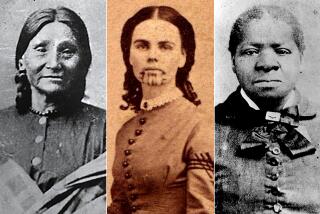Cannibals with courage
- Share via
DECLARING THAT there may be a shortage of evidence for cannibalism in the Donner Party is like announcing that the Titanic may still be afloat -- the most notable chapter of a legendary story is thrown into doubt.
The tale of the ill-fated pioneers of 1846 has transfixed Americans for a century and a half at least in part because of one universally known fact: snowbound and starving in the Sierra Nevada, members of the company were forced, out of dire necessity, to eat the dead.
So it’s no surprise that when an archeological team revealed last month that excavations at the campsite of the Donner families had produced no proof of cannibalism, the news came as a shock. But in reality, the information changes nothing about our fundamental understanding of the story. Company members did resort to cannibalism, and yet that is not, nor has it ever been, the utmost truth about the tale.
Much of the current befuddlement stems from the limited nature of the archeological dig along the banks of Alder Creek, not far from Truckee. This was the campsite of the two Donner families, including that of George Donner, whose election as captain lent the party its name. For the first time, archeologists located the families’ cooking hearth, allowing them to search for charred fragments of human bone. They found none, although there was plenty of evidence that the Donners ate game.
But this was one site among many in the story of the Donner Party, which included dozens of other people as well as the Donner families. When the early winter snow trapped the wagons, most members were several miles ahead of the Donner families, at what is today Donner Lake.
No one disputes that cannibalism occurred at Donner Lake or at other sites involved in the story. Even at Alder Creek, the new finding does not disprove the practice of cannibalism. There may be no evidence to find. Uncooked human bones would long ago have disintegrated, and the literature of survival cannibalism is replete with cases in which desperate survivors sliced the flesh from cadavers and cooked only this gruesome “meat.” Bones are usually boiled, so they can be eaten only after the supply of flesh is exhausted. Given what we know from the archival record of letters, journals and remembrances, cannibalism at Alder Creek would have occurred only for a short time by a limited number of people at the end of the tragedy. There simply may have been no need to cook and eat the bones.
It would certainly be ironic if no one named Donner engaged in the grim practice with which the family moniker will forever be associated. Determining the truth about that question is assuredly a scientific project worthy of study, and the current archeological team deserves credit for trying to resolve this minor mystery.
But unfortunately, and perhaps unintentionally, the researchers have occasionally fallen into the trap of attaching a moral weight to the issue of whether the Donners were cannibals. Acknowledging that the lack of bones doesn’t disprove the possibility of cannibalism, one researcher said, “no body doesn’t necessarily mean no crime.” And the team has put forward a descendant of the Donners who has even said that the findings “exonerate” her ancestor.
Such language implies that some members of the party wrongly resorted to cannibalism and are in need of exoneration. In one case, that is true. Two Native Americans who came to the party’s aid were shot and killed so they could be eaten -- an unforgivable act of madness. But in other cases in which human flesh was eaten, the actions bear no shame and need no moral acquittal. Eating the flesh of the dead was the only logical and reasonable course of action open to the living.
The real lesson of the Donner Party has nothing to do with the question of who did and who did not resort to cannibalism. Many of the tale’s most poignant moments precede not only the cannibalism, but also the entrapment in the Sierra. In the westward migration that is a central component of American history, the Donner Party story is the best example of average people thrust into extraordinary circumstances. These were farmers and merchants, fathers and mothers, aging grandparents and toddling youngsters -- and they endured an ordeal beyond imagining.
Forced into a crucible, their responses ran the gamut of human behavior -- from the base selfishness of people who abandoned an old man along the trail to the astonishing courage of a 9-year-old girl who, forced to separate from her mother, said simply, “Well Ma, if you never see me again, do the best you can.”
The Donner Party is often portrayed as a cautionary tale, and obviously there is a dark side, but at its root it is better understood as a reminder of the bravery and determination required of Western pioneers. They knew little about their destination, even less about how to get there. They knew there were dangers along the way and that those dangers multiplied with every hour of delay. Yet, in the hope of a better future, they uprooted their lives and left behind all that they had known.
No new piece of evidence -- nothing dug from the ground nor culled from an archive -- can change the basic truth that through the prism of the Donner Party it is possible to see not just the horrors that could accompany the journey to the West, but the courage it took to begin.


